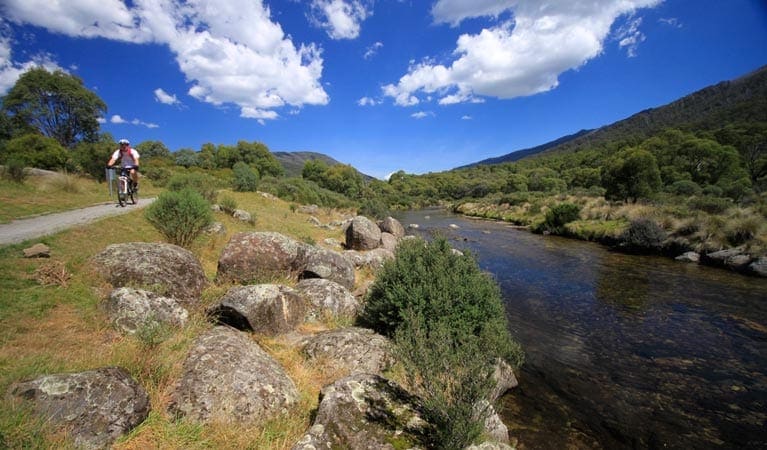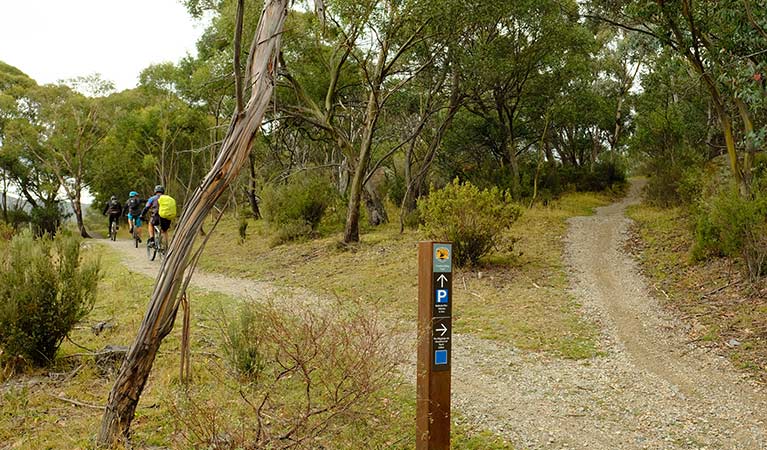Hike at a Glance
Max elevation: 0m
Min elevation: 0m
Total Ascent: 0m
Hike overview
Kosciuszko National Park is a mecca for mountain bikers, and Thredbo Valley track is one of its most popular (and easiest) adventures on two wheels.
Soak in the views of the Ramshead Range, and enjoy the fresh mountain air as you travel through tall mountain gum forest, snow gum woodland, and open grasslands. The trail meanders along the pretty Thredbo River valley and even crosses several photogenic suspension bridges. Keep an eye out for 400 year-old mountain plum pines and, in spring, flowering hovea with its purple 'hearts'.
If you prefer to tackle just a section of the track, there are access points at Thredbo Diggings campground or Ngarigo campground. Why not stay overnight, or stop here for a picnic and try your luck fishing in the Thredbo River. Bullocks Hut is a picturesque detour at the end of the track.
This track is mostly smooth riding or walking with some short climbs and descents, making it a great day out for casual cruisers and pros alike. For more mountain biking options visit the Thredbo website.
Tips
The track is an easy to moderate 3hr ride or 8hr walk one-way between Thredbo Alpine Village and Bullocks Hut Skitube Terminal.
Arrange a car shuffle, or take advantage of local shuttle services and guided tours in summer.
If you're riding a bike, please give way to walkers along this track.
Thredbo Valley track extension: This track is being extended downstream from Bullocks Flat to link with trails around Lake Jindabyne. Depending on construction works, a 6.5km section (13km return) may be open for riders keen to test their skills on this more challenging and remote part of the track.
Visit NSW National Parks and Wildlife Service for more information on this trail.
The longitude and latitude of the start and end points are approximately only and should not be used for navigation purposes. Please contact me if you know the correct coordinates.
Gallery
Got some great shots from this hike? Upload your photos here to inspire others and show off the beauty of the trail!
Click to view form >>
Submitting your photos doesn’t mean you lose ownership. You can be credited for your contributions, and you can request removal at any time.
Content use
Please don’t copy GPX files or content from this site to AllTrails or other platforms. Each trail has been personally mapped, documented, and refined to support Australia’s bushwalking and hiking community. While some details come from land managers, every listing reflects significant personal effort. This is a free, community-driven initiative—your respect helps keep it that way.
Walk map and GPX file
It looks like I don’t have a GPX file for this trail yet. If you have one to share, please email it to me! I’ll verify it against official maps before adding it to help other hikers have a safer, easier experience. Thanks for contributing to a better hiking resource.
Getting there
Getting to the trailhead: Kosciuszko National Park.
To Bullocks Flat. Thredbo Valley track runs from Thredbo Alpine Village to Bullocks Flat SkiTube Terminal, in Kosciuszko National Park. To get there:Leave Jindabyne on Kosciuszko RoadAfter 3km, turn left onto Alpine WayAfter entering Kosciuszko National Park, access the track at Bullocks Flat Skitube Terminal, Thredbo Diggings campground, Ngarigo campground or Thredbo Alpine Village. Park entry points Bullocks Flat See on map Friday Drive carpark See on map Road quality All 2WD vehicles need to carry snow chains in winter, between June and October long weekends, on: Kosciuszko Road (to Perisher) Guthega Road Alpine Way between Thredbo and Tom Groggin Snow chains are recommended for all vehicles driving in the park, including 4WD and AWD, in the event of extreme weather. Read our snow driving in Kosciuszko tips. Roads can close in extreme weather, so it’s a good idea to check weather and road conditions before setting out. Sealed roads Vehicle access 2WD vehicles Weather restrictions Snow chains required after snow Parking Parking is available at Bullocks Flat Skitube Terminal, Thredbo Diggings campground, Ngarigo campground and Thredbo Alpine Village, including several designated disabled spots.
Closest towns to this walk: Adaminaby, Cabramurra, Cooma, Crackenback, Dalgety, Jindabyne, Khancoban, Perisher Valley, Thredbo, Tumbarumba, Tumut
About the region
Kosciuszko National Park spoils you with snow sports, walks and mountain biking in the Snowy Mountains. Go camping, explore caves, climb Australia's highest mountain, or stay in heritage accommodation. There are 7 areas in this park:
1. Thredbo-Perisher area is your gateway to Mount Kosciuszko. Find NSW's favourite ski resorts, top alpine hikes, mountain bike trails, and endless adventures in the Snowy Mountains.
2. The Lower Snowy River area embraces the wild south of Kosciuszko National Park. Camp by the Snowy River and explore the scenic trails on a walk, bike or horse ride.
3. Khancoban area is the western gateway to Kosciuszko National Park. Discover Geehi and Tom Groggin's camp spots, fishing, and riding. Marvel at the Western Fall views or explore huts and hikes in the Jagungal Wilderness.
4. The Selwyn area is your perfect base to explore the walks, rides, and top fishing spots of central Kosciuszko National Park. Selwyn Snow Resort and historic Kiandra are closed due to severe fire damage.
5. The Yarrangobilly area is a highlight of northern Kosciuszko National Park. Explore jaw-dropping caves on a guided tour and swim in the thermal pool. Stay at historic Caves House and enjoy the walks and wildlife.
6. The Tumut area is your launch pad into northern Kosciuszko National Park. Discover water sports and wildlife at Blowering Reservoir. Camp and explore hidden walks and waterfalls in the foothills of the Snowy Mountains.
7. The High Plains area spoils you with summer walks, horse rides and bike trails to mountain huts, caves, and gorges. Camp, stay in Currango's heritage cottages, and discover Kosciuszko's wild north-east corner.
Similar walks nearby
Looking for more walks in or near Kosciuszko National Park? Try these trails with a similar difficulty grade.
Track grade
Grade 3 (Moderate) - Walks for Most Fitness Levels: Grade 3 on the AWTGS represents moderate walking tracks. These are ideal for walkers with some fitness who are comfortable with some hills and uneven terrain. While suitable for most ages, some bushwalking experience is recommended to ensure a safe and enjoyable experience. Tracks may have short, steep hill sections, a rough surface, and many steps. The total distance of a Grade 3 walk can be up to 20 kilometers.
Explore safe
Plan ahead and hike safely! Carry enough water, pack layers for changing conditions, and bring safety gear like a torch, PLB, and reliable communication device. Check official sources for trail updates, closures, and access requirements, and review local weather and bushfire advice. Most importantly, share your plans with someone before you go. Being prepared makes for a safer and more enjoyable hike! Stay Safe, Explore More, and Always #ExploreSafe.
Packing checklists
What you carry in your pack depends on factors like weather, terrain, and your adventure type. Not sure what to bring? My free planning, food, and packing checklists are a great starting point, covering day hikes, overnight trips, and multi-day adventures. Use them to customise your kit and always prioritise safety.
Let someone know
Before heading out, take a moment to fill out your trip intentions form. It’s a quick way to share your hike details with family or friends. If something goes wrong, they can notify emergency services, ensuring a faster response and peace of mind. Stay safe and enjoy your adventure
Suggest an edit
Spotted a change on this trail? Maybe there are new features, the route has shifted, or the trail is permanently closed. Whatever the update, I’d love your input. Your feedback helps fellow hikers stay informed and ensures that our trail info stays fresh and reliable.
Acknowledgement of Country
Trail Hiking Australia acknowledges the Traditional Owners of the lands on which we hike and pay respects to their Elders, past and present, and we acknowledge the First Nations people of other communities who may be here today.






